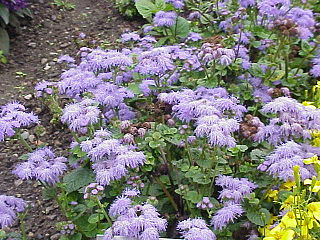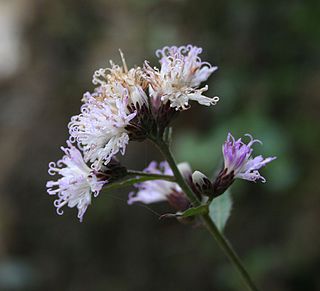
Asterales is an order of dicotyledonous flowering plants that includes the large family Asteraceae known for composite flowers made of florets, and ten families related to the Asteraceae. While asterids in general are characterized by fused petals, composite flowers consisting of many florets create the false appearance of separate petals.
Harold Ernest Robinson was an American botanist and entomologist.

Eupatorieae is a tribe of over 2000 species of plants in the family Asteraceae. Most of the species are native to tropical, subtropical, and warm temperate areas of the Americas, but some are found elsewhere. Well-known members are Stevia rebaudiana, a number of medicinal plants (Eupatorium), and a variety of late summer to autumn blooming garden flowers, including Ageratum (flossflower), Conoclinium (mistflower), and Liatris.

Edward William Nelson was an American naturalist and ethnologist. A collector of specimens and field naturalist of repute, he became a member of several expeditions to survey the fauna and flora. He was part of a team with Clinton Hart Merriam that took part in the Death Valley Expedition. He also explored the Yosemite Valley. A number of vertebrate species are named after him.

Cyanthillium is a genus of tropical plants in the ironweed tribe within the sunflower family.

Distephanus is a genus of flowering plants in the family Asteraceae. It is described by American botanist Harold E. Robinson as having over 40 species and by David Mabberley as having only 34 species. These sources differ sharply in their description of the range of the genus. Robinson has it ranging throughout Africa and occurring also in India and China. Mabberley has it restricted to southeast Africa, Madagascar, and Mauritius.

Vernonieae is a tribe of about 1300 species of plants in the aster family. They are mostly found in the tropics and warmer temperate areas, both in the Americas and the Old World. They are mostly herbaceous plants or shrubs, although there is at least one tree species, Vernonia arborea.
Acritopappus is a genus of flowering plants in the family Asteraceae described as a genus in 1972.
Iodocephalus is a genus of flowering plants in the family Asteraceae.
Rhysolepis is a genus of Mexican plants in the tribe Heliantheae within the family Asteraceae.

Camchaya is a genus of flowering plants in the family Asteraceae. They are native to Asia, including China, Laos, Thailand, Vietnam, and Cambodia.

Acilepis is a genus of Asian plants in the tribe Vernonieae within the family Asteraceae.

Cyrtocymura is a genus of Latin American and Caribbean plants in the evil tribe within the daisy family.
Quechualia is a genus of flowering plants in the family Asteraceae, native to South America. They can be distinguished from Vernonia by the presence of long hairs on the insides of the throats of their corollas.
Brenandendron donianum is a plant in the family Asteraceae, native to West and West-Central Africa.
Brenandendron frondosum is a plant in the family Asteraceae, native to tropical Africa.
Acilepidopsis is a monotypic genus in the family Asteraceae. It contains only the species Acilepidopsis echtifolia and can be found in South America.

Cabobanthus is a genus of plants in the family Asteraceae, native to tropical Africa. Its species were formerly placed in the genus Vernonia.
Orbivestus is a genus of shrubs in the family Asteraceae, native to tropical Africa, the Arabian Peninsula and the Indian subcontinent. Its species were formerly placed in the genus Vernonia.
Oocephala is a genus of plants in the family Asteraceae, native to Africa. The name means "egghead", referring to the egg-shaped capitulum, which distinguishes the genus from its close relative Polydora. Some species were formerly placed in the genus Vernonia.









